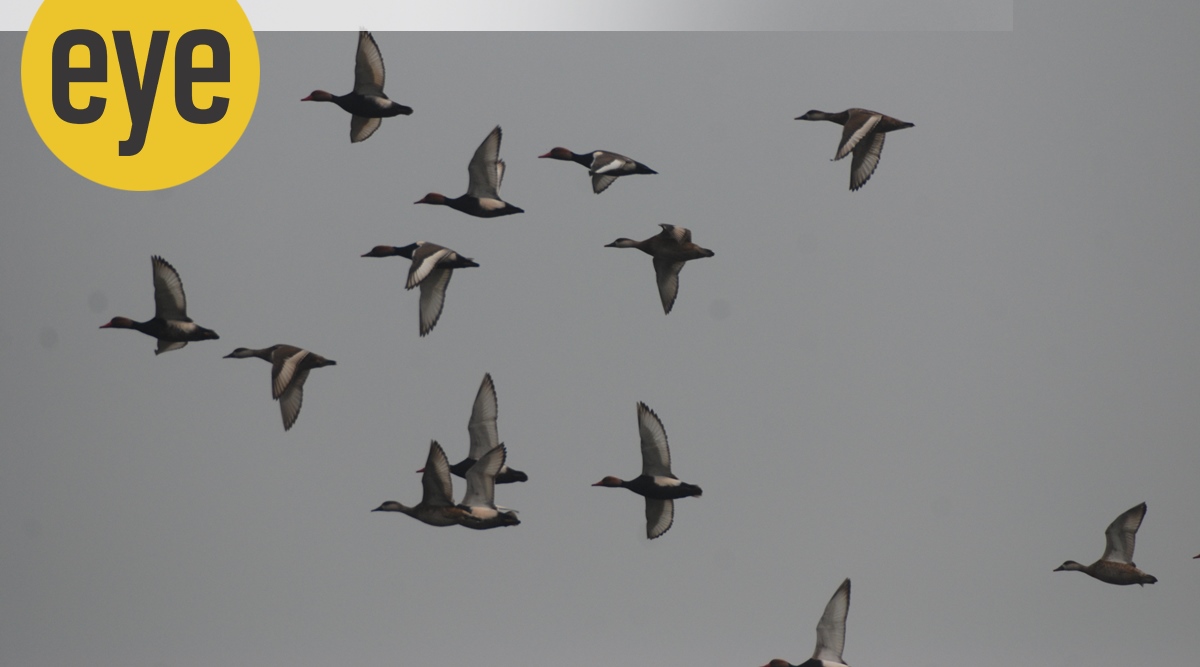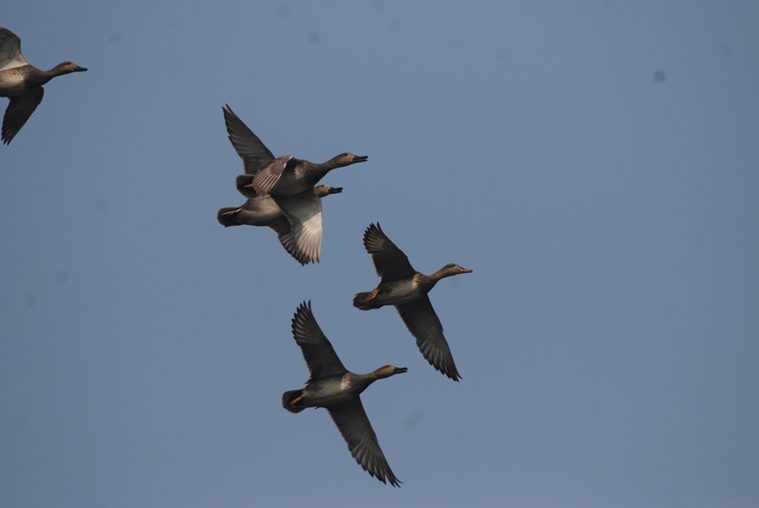 Ducks on their way back home. (Credit: Ranjit Lal)
Ducks on their way back home. (Credit: Ranjit Lal) For us warm, tropical beings, there is nothing more dispiriting than chilling, grey winter days, with a sullen sky dribbling down a thin rain, which nevertheless manages to turn the garden into a quagmire in very short order. Leaves droop miserably, birds huddle stoically; even monkeys look miserable and wet cats, well, look like wet cats! I stare out into the turgid gloom: Mother Nature looks at her bedraggled worst! And I wonder about those optimistic birds that have flown down thousands of kilometres from the frozen north just to avoid this kind of steely chill.
Then, the first signs of optimism: as if wiping down a foggy bathroom mirror the sky suddenly clears overnight. When I awake, pale sabers of gold are trying to stream through the bedroom window and there is the sun, blazing egg-yolk gold. I step out tentatively into the still soggy garden and am brought up short. There’s a bed of small Indian roses right outside, that valiantly struggles to flower through the summer months before coming into its own in winter. The pink blooms are normally quite small, judging by the gigantic goblets you see in pedigreed rose gardens in the city, but this morning there is a King butterfly in my tiny rose-bed. A rose so large its stalk can barely hold it up, surrounded by a coronet of garnet buds. Foolishly, I photograph it with my archaic mobile and not the camera, so the image is not good enough to reproduce, but the bloom has done its job; lifted the mood of the morning.
Later that afternoon, I hear the excited cheeping of purple sunbirds on the bougainvillea on my balcony. It’s a pair, and the male hasn’t even fully changed into his glittering glad rags breeding attire. They are probing for nectar from the blooms, all right, but there seems to be something more going on here. The systematic way they work their way up and down the creeper makes me think they’re checking it out as a site for a future residence. They’re scouting and working on their hopes already, in the middle of January — cheerful, excited and uncaring of the minefield of hazards that may lie ahead. It’s a wonderful mood turbo-booster, even if they are probably just being led up the garden path! Sunbirds really start going stir-crazy about each other around March.
One of the main triggers that send migratory birds off on their marathon journeys (more than ambient temperature) is said to be photoperiodism: the length of the day. Once the critical day-length is achieved, the birds just know it’s time to go: like I suppose you would know when you need to go to the bathroom. Relying on the weather to time departures or to begin courting can be tricky. A sudden cold snap or a warm interlude can cause all kinds of confusion to travel plans.
 Ducks on their way back home (Credit: Ranjit Lal)
Ducks on their way back home (Credit: Ranjit Lal) Years ago, in the Sultanpur National Park, Gurugram, I remember we spent half the night out on the lakeside. You couldn’t see very much, but yes, the birds were still up and about: Redshanks, snazzy avocets, sandpipers, black-winged stilts (which are resident) and other waders were scything and probing the mud with their needle bills, getting themselves a late dinner and frantically fattening up for the long journey ahead; calling softly to each other all the while. From the distance came the throaty guttural murmur of ducks, turning topsy-turvy: they were late diners, too, and also knew it was safest and most relaxing to dine in darkness when most predators like the marsh harrier or assorted eagles would be asleep.
We were back at the lakeside before dawn the next morning to witness another uplifting spectacle. Out there in the middle of the lake, the common cranes were lining up like aircraft on the flyway preparatory to take off — reminding you of an international air terminal seeing off its first flights of the day. There was much tumultuous trumpeting and then one by one, they began to run through the shallow water, flapping their huge wings until lift-off was obtained. They circled the lake and then headed out in graceful echelons, like bombers on a mission. They’d got the green light to go!
Later, high from a piercing blue sky (a rare phenomenon now) a heart-stopping grapeshot whine makes you look up. From the south, squadrons of tiny black jets are whistling over like shrapnel — ducks! They spot the lake and just drop down, turning over on their sides and “whiffling” (as it is called) and tumbling down, down, down, righting themselves at the last moment, braking with their wings and tail and touching down gently. Then a happy tail-wag and satisfied throaty “wak-wak” for a job well done! They’ll soon be on their way again, but your day can’t go wrong after witnessing that exuberant display of flying!
The gents, in fact, are already in their immaculate shining silks and satins and have started looking for partners. On another occasion, again at Sultanpur, the ruff, in their elaborate Elizabethan frills and finery, had started “lekking” — wooing their ladies and staking out small territories — rehearsing for when they would reach their summer homes, still thousands of kilometres away.
At the moment, the grey chill has clamped down again like an icy vice and the sunbirds have vanished again! But they and so many others are just biding their time: the days will lengthen, the sun will dazzle and they’ll be out there, centre stage, frantic with the business of raising new families. And the last flights of migrants will be speeding north, equally eager to ensure that life and the world will go on as ever.
- The Indian Express website has been rated GREEN for its credibility and trustworthiness by Newsguard, a global service that rates news sources for their journalistic standards.

